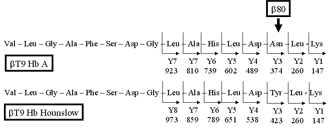


A NEW SILENT β CHAIN VARIANT: Hb HOUNSLOW [β 80(EF4)Asn→Tyr]
Préhu C1,2, Riou J2, Henthorn J3, Wajcman H1,2*
*Corresponding Author: Dr. Henri Wajcman, INSERM U841 eq 11, Hôpital Henri Mondor, 94010 Créteil, France; Tel.: +33(0)1-49-81-35-78; Fax: +31(0)148-99-33-45; E-mail: Henri.Wajcman@im3.inserm.fr
page: 29
|
|
DISCUSSION
Hb Hounslow is an example of a variant which has no charge difference from Hb A and is silent in IEF. However, two other variants that carry the same amino acid exchange (Asn→Tyr), namely Hb Saint Mandé [β102 (G4)] and Hb Aurora [β139(H17)] are both well separated from Hb A by this technique (6). Hb Hounslow was detected because of its behavior on cation exchange HPLC, in which the retention time depends not only upon the difference in charge but also on other interactions with the stationary phase that result from local modifications induced by the mutation. Several variants, which behave like Hb Hounslow, include Hb Alzette [β104(G6)Arg→Lys], Hb Puttelange [β140(H18)Ala→Val] and Hb Rainier [β145(HC2)Tyr→Cys] [6]. Many of the neutral variants described are clinically silent or have minimal hematological consequences in the heterozygous state but some interact with a thalassemia trait, resulting in a thalassemia intermedia phenotype or with a sickle cell trait and favor sickling. When screening for a specific abnormality, such as Hb S or a thalassemic phenotype, one method may be sufficient to reveal the defect, but it is important to be aware that another silent abnormality may coexist and act as a gene modifier. Thus, phenotype screening should include at least two methods that explore different properties in order not to miss a neutral variant. Additional techniques such as reversed phase HPLC and ES-MS may show the presence of a neutral variant when a combination of IEF and cation exchange HPLC fail to reveal it, while hematological arguments would suggest its presence. For example, these two last techniques were required for detecting Hb Zoetermeer [α21(B2)Ala→Ser] [7].
Residue EF4, which is modified in Hb Hounslow, is located externally near to the 2,3-DPG binding pocket. A comparison of more than 1,100 sequences of molecules from the globin family (Hbs, myoglobins, cytoglobins and neuroglobins from various species) showed that this position is mostly occupied by an aspartic acid (35%) or an asparagine (30%) and means that conservation of the size of this residue and a possibility for hydrophilic interaction may be important in evolution [8]. Hb G-Szuhu (Asn→Lys), also clinically silent, is the other b chain variant that involves position EF4 [9].

Figure 4. Y series of ions observed by MS/MS.
|
|
|
|



 |
Number 27
VOL. 27 (2), 2024 |
Number 27
VOL. 27 (1), 2024 |
Number 26
Number 26 VOL. 26(2), 2023 All in one |
Number 26
VOL. 26(2), 2023 |
Number 26
VOL. 26, 2023 Supplement |
Number 26
VOL. 26(1), 2023 |
Number 25
VOL. 25(2), 2022 |
Number 25
VOL. 25 (1), 2022 |
Number 24
VOL. 24(2), 2021 |
Number 24
VOL. 24(1), 2021 |
Number 23
VOL. 23(2), 2020 |
Number 22
VOL. 22(2), 2019 |
Number 22
VOL. 22(1), 2019 |
Number 22
VOL. 22, 2019 Supplement |
Number 21
VOL. 21(2), 2018 |
Number 21
VOL. 21 (1), 2018 |
Number 21
VOL. 21, 2018 Supplement |
Number 20
VOL. 20 (2), 2017 |
Number 20
VOL. 20 (1), 2017 |
Number 19
VOL. 19 (2), 2016 |
Number 19
VOL. 19 (1), 2016 |
Number 18
VOL. 18 (2), 2015 |
Number 18
VOL. 18 (1), 2015 |
Number 17
VOL. 17 (2), 2014 |
Number 17
VOL. 17 (1), 2014 |
Number 16
VOL. 16 (2), 2013 |
Number 16
VOL. 16 (1), 2013 |
Number 15
VOL. 15 (2), 2012 |
Number 15
VOL. 15, 2012 Supplement |
Number 15
Vol. 15 (1), 2012 |
Number 14
14 - Vol. 14 (2), 2011 |
Number 14
The 9th Balkan Congress of Medical Genetics |
Number 14
14 - Vol. 14 (1), 2011 |
Number 13
Vol. 13 (2), 2010 |
Number 13
Vol.13 (1), 2010 |
Number 12
Vol.12 (2), 2009 |
Number 12
Vol.12 (1), 2009 |
Number 11
Vol.11 (2),2008 |
Number 11
Vol.11 (1),2008 |
Number 10
Vol.10 (2), 2007 |
Number 10
10 (1),2007 |
Number 9
1&2, 2006 |
Number 9
3&4, 2006 |
Number 8
1&2, 2005 |
Number 8
3&4, 2004 |
Number 7
1&2, 2004 |
Number 6
3&4, 2003 |
Number 6
1&2, 2003 |
Number 5
3&4, 2002 |
Number 5
1&2, 2002 |
Number 4
Vol.3 (4), 2000 |
Number 4
Vol.2 (4), 1999 |
Number 4
Vol.1 (4), 1998 |
Number 4
3&4, 2001 |
Number 4
1&2, 2001 |
Number 3
Vol.3 (3), 2000 |
Number 3
Vol.2 (3), 1999 |
Number 3
Vol.1 (3), 1998 |
Number 2
Vol.3(2), 2000 |
Number 2
Vol.1 (2), 1998 |
Number 2
Vol.2 (2), 1999 |
Number 1
Vol.3 (1), 2000 |
Number 1
Vol.2 (1), 1999 |
Number 1
Vol.1 (1), 1998 |
|
|

